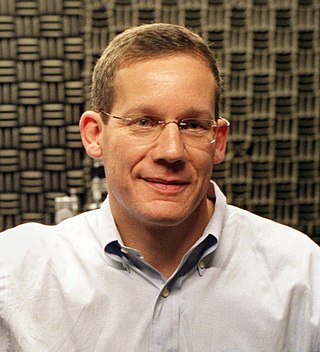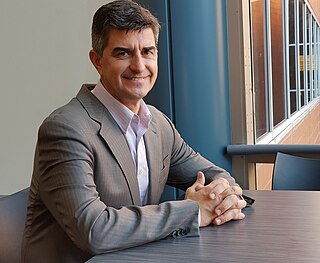Related Research Articles

A ceramic is any of the various hard, brittle, heat-resistant, and corrosion-resistant materials made by shaping and then firing an inorganic, nonmetallic material, such as clay, at a high temperature. Common examples are earthenware, porcelain, and brick.

Materials science is an interdisciplinary field of researching and discovering materials. Materials engineering is an engineering field of finding uses for materials in other fields and industries.

The College of Engineering is a division of Cornell University that was founded in 1870 as the Sibley College of Mechanical Engineering and Mechanic Arts. It is one of four private undergraduate colleges at Cornell that are not statutory colleges.

Charles M. Lieber is an American chemist, a pioneer in nanoscience and nanotechnology, and a convicted felon. In 2011, Lieber was named the leading chemist in the world for the decade 2000–2010 by Thomson Reuters, based on the impact of his scientific publications. He is known for his contributions to the synthesis, assembly and characterization of nanoscale materials and nanodevices, the application of nanoelectronic devices in biology, and as a mentor to numerous leaders in nanoscience.
Ceramic membranes are a type of artificial membranes made from inorganic materials. They are used in membrane operations for liquid filtration.

International Technological University (ITU) is a private university in Santa Clara, California. It was founded in 1994 by Professor Shu-Park Chan, previously a professor and interim dean of the School of Engineering at Santa Clara University. Although the university is accredited by the WASC Senior College and University Commission, the accreditor has begun to rescind its accreditation; ITU remains accredited while it appeals that decision.

Solid is one of the four fundamental states of matter. The molecules in a solid are closely packed together and contain the least amount of kinetic energy. A solid is characterized by structural rigidity and resistance to a force applied to the surface. Unlike a liquid, a solid object does not flow to take on the shape of its container, nor does it expand to fill the entire available volume like a gas. The atoms in a solid are bound to each other, either in a regular geometric lattice, or irregularly. Solids cannot be compressed with little pressure whereas gases can be compressed with little pressure because the molecules in a gas are loosely packed.
Walter Eric Spear FRSE PhD FRS FInstP was a German physicist noted for his pioneering work to help develop large area electronics and thin film displays. He was born in Frankfurt to a Jewish father and a Lutheran mother; by the time he finished his school examinations in 1938 life for Jews and people associated with Jews was becoming difficult. With the support of friends and relatives in Britain, the family were able to move to London, where he arrived in 1938 "with a small suitcase and a large cello".
A network solid or covalent network solid is a chemical compound in which the atoms are bonded by covalent bonds in a continuous network extending throughout the material. In a network solid there are no individual molecules, and the entire crystal or amorphous solid may be considered a macromolecule. Formulas for network solids, like those for ionic compounds, are simple ratios of the component atoms represented by a formula unit.

Crystalline silicon or (c-Si) Is the crystalline forms of silicon, either polycrystalline silicon, or monocrystalline silicon. Crystalline silicon is the dominant semiconducting material used in photovoltaic technology for the production of solar cells. These cells are assembled into solar panels as part of a photovoltaic system to generate solar power from sunlight.

Wahid Shams-Kolahi is a scientist and an electrical engineer who is known for his research in photovoltaic-related technologies.
Mark G. Allen is a professor specializing in microfabrication, nanotechnology, and microelectromechanical systems at the University of Pennsylvania, where he is currently Alfred Fitler Moore Professor of Electrical and Systems Engineering Director of the Singh Center for Nanotechnology, and leader of the Microsensor and Microactuator Research Group. Prior to his joining the University of Pennsylvania in 2013, he was with the Georgia Institute of Technology, where he was Regents' Professor of Electrical and Computer Engineering and the J.M. Pettit Professor in Microelectronics. While at Georgia Tech, he also held multiple administrative positions, including Senior Vice Provost for Research and Innovation; Acting Director of the Georgia Electronic Design Center; and Inaugural Executive Director of Georgia Tech's Institute for Electronics and Nanotechnology. He was editor in chief of the Journal of Micromechanics and Microengineering (JMM), and currently serves on the editorial board of JMM as well as the journal Microsystems and Nanoengineering.
Zeynep Çelik-Butler is a Turkish-American professor of electrical engineering at the Nanotechnology Research and Teaching Facility within the College of Engineering at the University of Texas at Arlington. There are two distinctly different areas of research within the group.

Roger Thomas Howe is the William E. Ayer Professor of Electrical Engineering at Stanford University. He earned a B.S. degree in physics from Harvey Mudd College and M.S. and Ph.D. degrees in electrical engineering from the University of California, Berkeley in 1981 and 1984, respectively. He was a faculty member at Carnegie-Mellon University in 1984-1985, at the Massachusetts Institute of Technology from 1985-1987, and at UC Berkeley between 1987-2005, where he was the Robert S. Pepper Distinguished Professor. He has been a member of the faculty of the School of Engineering at Stanford since 2005.

Yury Georgievich Gogotsi is a Ukrainian scientist in the field of material chemistry, professor at Drexel University, Philadelphia, PA since the year 2000 in the fields of Materials Science and Engineering and Nanotechnology. Distinguished University and Trustee Chair professor of materials science at Drexel University — director of the A.J. Drexel Nanotechnology Institute.

Amorphous silicon (a-Si) is the non-crystalline form of silicon used for solar cells and thin-film transistors in LCDs.

Lisa Marie Spellman Porter is an American materials scientist who is a Professor of Materials Science at Carnegie Mellon University. She works on new ways to process and characterise electronic materials. She has previously served as president of the American Vacuum Society.
Yu-Hwa Lo is a physicist, engineer, academic and researcher. He is a Professor of Electrical and Computer Engineering at University of California at San Diego (UCSD).

Sandip Tiwari is an Indian-born electrical engineer and applied physicist. He is the Charles N. Mellowes Professor of Engineering at Cornell University. His previous roles were Director of National Nanotechnology Users Network, Director of the National Nanotechnology Infrastructure Network, and research scientist at IBM T. J. Watson Research Center. He is best known for his pioneer research in the fields of SiGe transistor and nanocrystal memory.
References
- ↑ "Harris, Dr. Gary Lynn". Who's Who Among African Americans. 2009. Retrieved 26 February 2015.
- 1 2 Phillips, Bruce E. (2015). "Science Spectrum Trailblazers" . Retrieved 26 February 2015.
- ↑ "Howard Nanoscale Science and Engineering Facility". Howard University. Archived from the original on 11 November 1998. Retrieved 26 February 2015.
- 1 2 Webster, Raymond (1999). African American Firsts in Science and Technology. Gale Group. p. 139. ISBN 0787638765.
- ↑ "About us". National Nanotechnology Infrastructure Network. Retrieved 26 February 2015.